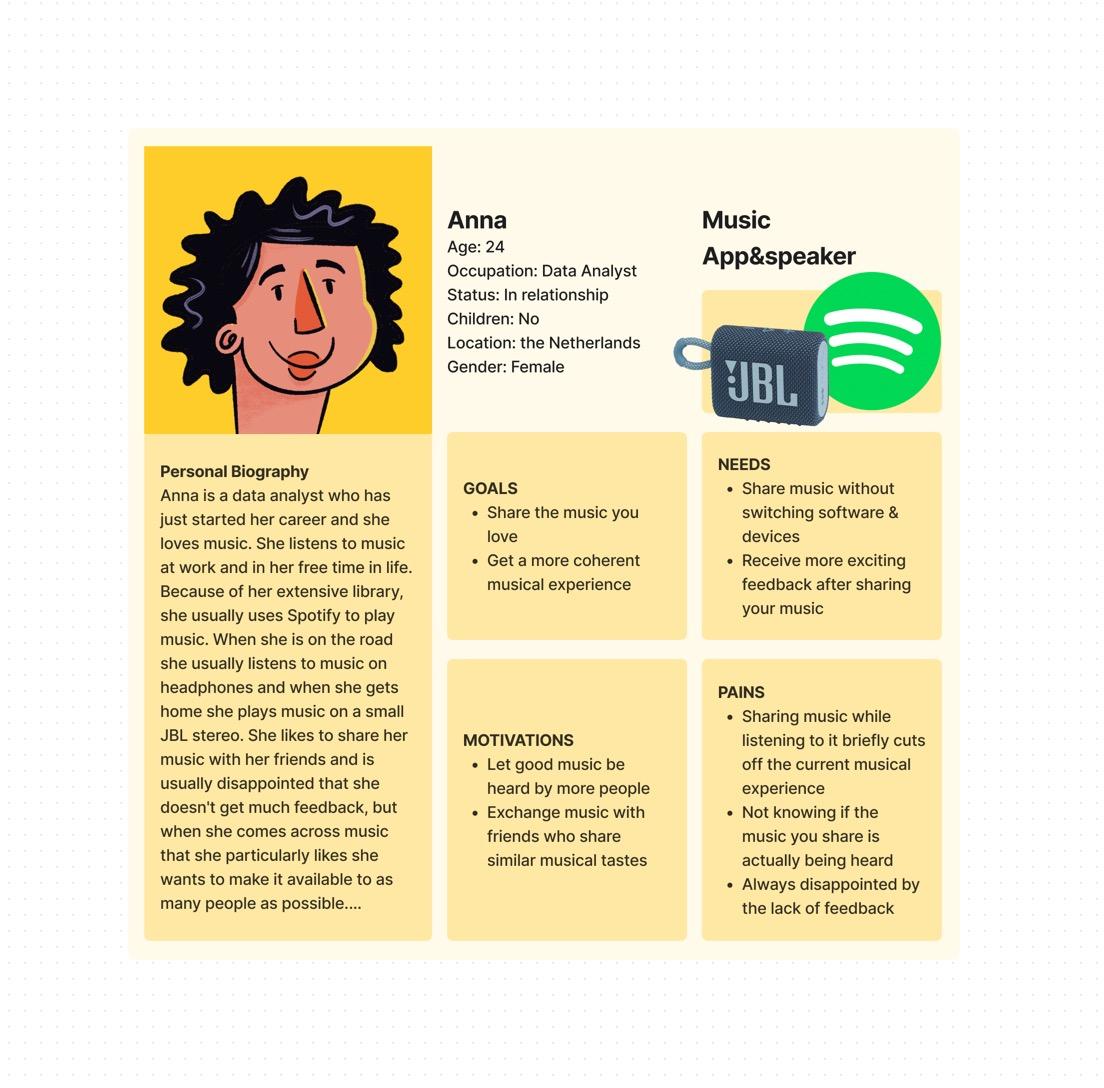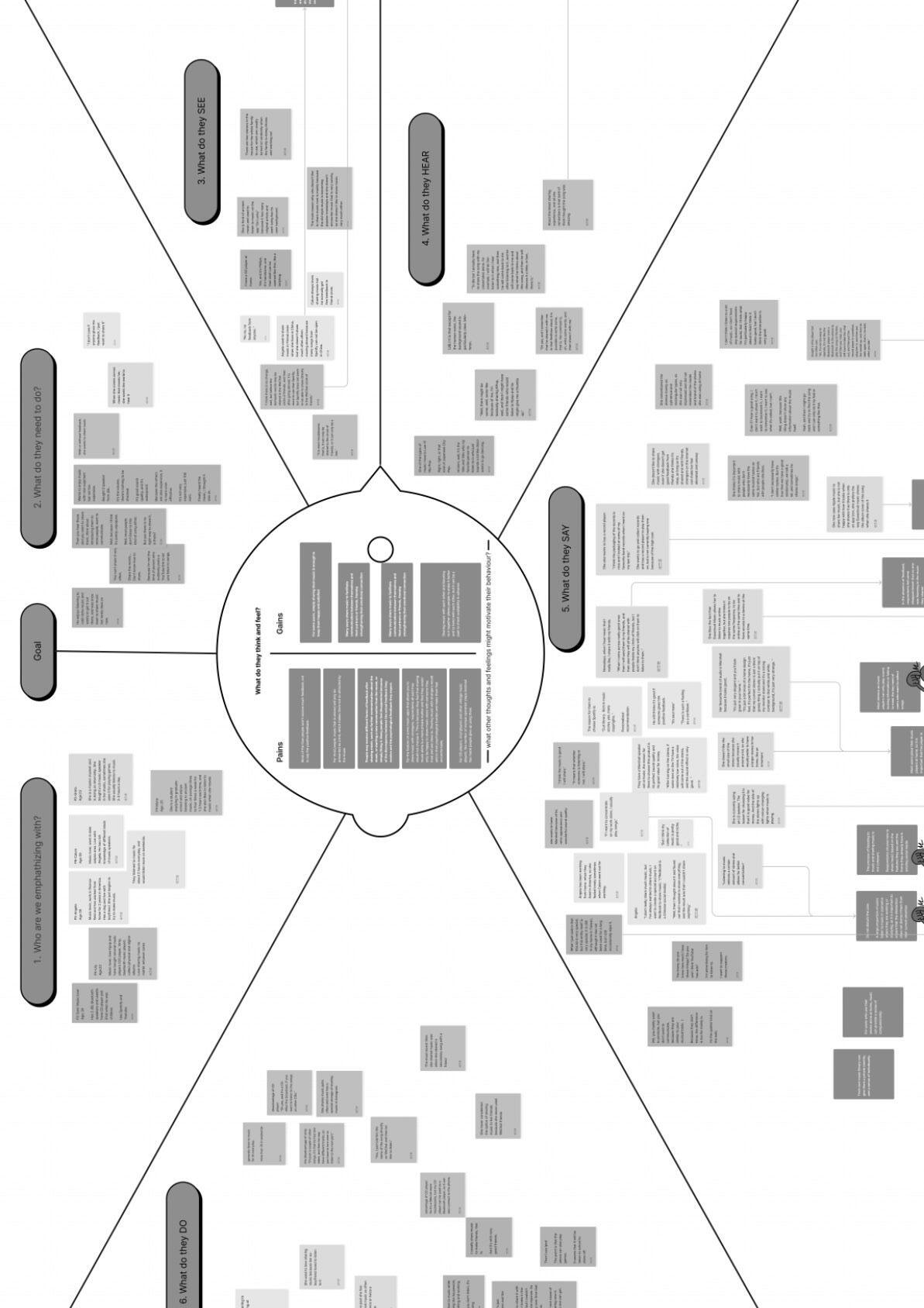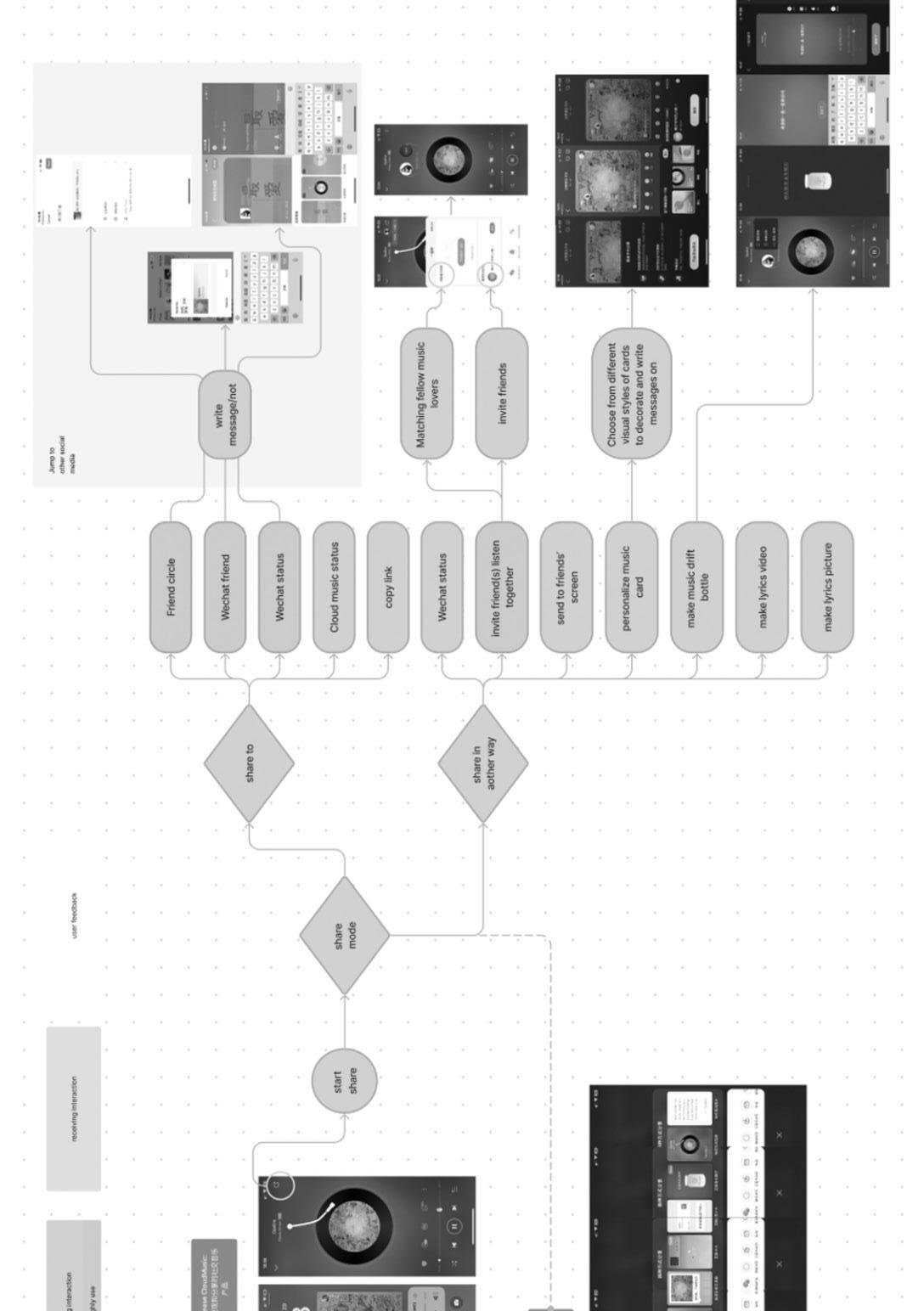
12 minute read
MUSIC LINKER
First Set Up
Add the device to your App You can self name your device and get relevant information
Advertisement


INVITE FRIENDS AND SEND MUSIC MESSAGE





Ui Design

This section shows the design of the interface for the online platform and includes only the interfaces that correspond to the key steps in the physical interaction process. This is to facilitate the reader and the participants in the user test process in understanding how the physical product corresponds to the streaming platform.



The photo used for 宇多田ヒカル is derived from: https://www.universal-music.co.jp/utada-hikaru/ Instagram Logo is derived from: https://commons.wikimedia.org/wiki/File:Instagram_logo_2016.svg










7.1 METHODOLOGY
Participants
For this user test, I recruited participants by posting about the information on social media, and eight students from different disciplines at Eindhoven University participated. The participants were aged between 22 and 27 years old, of which six were female and two were male. The test was conducted in strict compliance with the Ethical Review Board (ERB) from the Industrial Design department. All participants read and signed the Consent Form with details of the test procedure, data collection, and privacy protection prior to the test. In the subsequent analysis, all the data collected in the experiment were anonymized. The basic information about the participants and their anonymization numbers is shown in Table 2.
using the product for the first time. After an introduction to the product, the participant was asked to complete two simple tasks based on the themes of sharing music and receiving information about music. Each task had a specific scenario and exact instructions. In order to provide the participants with a homelike environment, I invited two of the participants who lived in the same apartment as me to test the product in my home. The remaining six to test it in a laboratory setting that was set up to simulate a living room environment. The two test tasks and the specific instructions can be found in Appendix B.
After the tests were completed, the participants were asked to take a semistructured interview to further demonstrate the user experience with Music Linker. The interview will start with the participant's basic music-related habits and experience of sharing music. Finally, the interview will return to the experience of using the Music Linker itself, asking the participant about the specific shape of the product, how it physically interacts with the lights, the overall interaction process, and what functions they feel are missing or would like to see added during the process.
The whole experiment was divided into three parts: introduction, test, and interview, and took about 30 minutes in total.
At the beginning of the experiment, participants were given a copy of the product instruction booklet to read on their own and were able to ask questions and have them answered by me at any time if they did not understand or were confused. During this process, I noted all the things that they found difficult to understand when

Analysis
For all the audio recordings collected during the interviews, I first transcribed them into Word documents. For all the transcribed textual information, as well as the observations of the user's use of the product during the interviews, I used Thematic Analysis for coding [19]. During the analysis, three broad thematic codes were created: Aesthetics, Experience and Expectation.
7.2 FINDINGS
The participants were generally appreciative of Music Linker as an innovative product for physical music sharing and were willing to explore its usability. However, through the observations of users in actual use and the analysis of interview data in the user tests, Music Linker still has much room to improve.
Aesthetics
In terms of overall appearance, the majority of participants expressed their appreciation of the shape of the product and felt that the simple but design-oriented shape would be a good decoration for their home.
However, some felt that the overall look did not clearly highlight the theme of sharing music. When asked if the shape of the product helped users to associate the product with music sharing, A2 said, "I think the image of the top half of the product is quite consistent, but when it is closed, I can't see the shape inside, so it feels a bit introverted, that is, at first glance, I might not think that there is a screen and audio inside. " A5 also mentioned in the interview that when the earpiece is on top of the lower part, the features related to the theme of sharing music are not obvious. A6 said that the element of the earpiece is visible when it is open, but "it's slightly less imaginable when it's closed."
There are two other details need to improve to the styling of the Music Linker. Firstly, when reading the instructions, more than one user had questions about the process of selecting the target audience, and they were mainly focused on the step of pressing the button to confirm after rotating it. The main reason for this is that the confirmation function and the rotation of the selected object are performed by the same button, which may cause confusion for the user at the first operation. In addition to this, I observed that during the swiping of the button, the user tends to press the upper surface of the button to swipe. This usage increases the risk of mistouching during the process, which could lead users to press the button during the swipe to send it to the wrong person to share it with.
Secondly, the Bluetooth connection button on the top of the earpiece is confusing to users. Several users pressed the button first when receiving a music message during the test, even though there are no instructions to do so in the product instruction manual. This might be because the earpiece as a whole is used for music reception, and most users would normally do something to confirm reception before receiving a message.
Experience Interaction
In terms of interaction semantics, participants reported that they felt a sense of connection through music when using the product, which is exactly what the product hopes to offer users in terms of interaction. A3 said, "I think it fits well with the theme of sharing music in my mind; there is an act of listening and then there is a more intuitive act of sharing, and the overall message is clearer."
In terms of ergonomics, it is unfortunate that the design of the earpiece does not provide a good grip for the user. During the test, I observed a number of participants trying to use the model for the first time in slow movements and expressing doubts about how to grip it properly. A3 said, "It's a bit hard to hold, it slips."
Compared With Normal Music Share Flow
The performance of this physical model in terms of receiving music information is a significant improvement in user usability and experience compared to the traditional music sharing flow. During the experiments, participants stated that the feature of flashing lights to indicate music information was the most significant difference compared to the traditional music sharing flow, and that they all appreciated and liked this form of interaction to varying degrees. This is because all participants indicated that their usual way of sharing music is by forwarding links to songs on social media platforms, which makes information such as the name of the song and the artist directly visible at first glance, which may have a significant impact on whether the recipient of the shared music is interested in opening it. A3 commented that "before, music was shared by sending a message, and that didn't make me want to click on it. Because I can see directly what the song title is and who the artist is, and if I don't like it, I really won't click on it at all, but with this one, it's just a light, and I'm most curious about what it is, why it's on, who's sending the message to make it light up, and I just want to listen to it and feel like opening a blind box." A2 said, "This model really exceeded my expectations, it's the feedback from the light or whatever it is that really makes me feel like, let's see who's sharing the song with me."
In particular, many participants felt that this type of message cue would encourage them to share the music more often, and A2 thought that "the flashing light would be a very motivating way. I would expect people to share it with me, and then we would share it with each other." Similarly, A3 mentioned that "it makes me more open to others sharing their music."
Also, the light indicator that gently reminds users of the availability of music messages without being intrusive to what they are currently doing, was also mentioned by many participants as a more comfortable experience than traditional forms of music sharing.
As for the process of sharing music, Music Linker received mixed reviews. Most users said that using a physical product to share music adds a lot of ritual. A6 also said, "I feel like usually, if I want to share music, I'm more likely to do it directly with the App. So I think I only prefer the way it receives music."

Expectation
The form of feedback that user desired
When asked about the features they would like to have added, the most frequently mentioned one was that they would like to have simple feedback channels. For example, A5 would like to be able to see if the message was read by the recipient; for her, knowing that they received and opened the message is sufficient feedback. More participants wanted a simple way to tell the person if they liked the music, with A1 saying, "Just to be able to send another message to say if they liked it or not and that sort of thing."
More possibilities for light interaction design
After showing their appreciation for the light cues, two participants suggested that they would like to see more interesting light signals. A6 wanted the interaction of the lights to be customizable to set: "There could be such a thing that would allow the lights to be changed by themselves so that they could be played with friends for a bit."
A8 would like the light to be constantly on, to maintain a regular brightness when there are no music messages, and to flash when there are messages, so as to provide the user with a sense of certainty that the product is ready for use. In addition, he wanted the light to change to respond to the user's actions when sharing music or other
7.3 LIMITATIONS
First if all, there was a disproportionate number of women in the test audience. In the world of product design, it is generally believed that gender differences influence aesthetic choices to a greater or lesser level [27].
Secondly, this trial was limited to observing consumers' initial responses and brief encounters with the product. In fact, it is intended that the product would interactions were completed, and for the associated app to behave correspondingly.
The need for external playback of the earpiece
A number of participants mentioned that when receiving music messages, they would like the earpiece to be placed on a table or other flat surface for playback. A3 said, "It's not convenient for me to hold and listen to a song if I'm on my phone or using another device at the moment." The average length of a song is 2–3 minutes, and if more songs are shared, the listening time will be longer. The design of the earpiece makes it necessary for users to hold the product in one hand for long periods of time, which can cause fatigue and make it difficult for them to do other things.
The need in different scenarios
A1 suggested that this physical product might not be easy to use in the environment where she usually listens to music, and the same concern was raised in A3's interview. From the interviews about the participants' usual music listening and music sharingrelated behaviour, it was clear that many of the participants listened to music on mobile transport or outdoors, such as at school or work. Therefore, the physical product part of the shared music service is not applicable to this type of outdoor listening scenario.
7.4 DISCUSSION AND FUTURE WORK
The goal of this project is to inspire people to share and converse more about music. Currently, there is a wealth of research on the technical and permissions aspects of music sharing. However, studies on the music sharing experience are few and far between, and are mostly focused on interface design and the distribution of music on online media platforms.
Music Linker, as an innovative attempt at a physical music sharing service, has yielded valuable insights from its design process and user-test phase, contributing to the following three main dimensions: keep customers inspired to share music throughout time, whether they do so enthusiastically or by receiving information from others. However, users may only get a fleeting glimpse of the design and usage of this cutting-edge device throughout the 30-minute experimenting phase. Particularly for a product that offers the user a feeling of ritual through physical connection, people's initial enthusiasm for a new product is likely to wane with time.
BE PAID TO THE WAY IN WHICH INFORMATION IS PRESENTED.
As can be seen from the findings, the interactive process of receiving music information was generally appreciated and discussed by the participants. It is also the most significant improvement in this physical product compared to the music sharing process in streaming music services. From the pre-project user interviews and research on the current mainstream streaming apps, it is already evident that shared information is more likely to be accepted when it is more visually appealing. For example, among the various ways of sharing music, exchanging vinyl records is more attractive than directly sharing web links. One important reason is that vinyl has a unique design aesthetic and a retro feel. Based on this, Music Linker has created a new way of prompting music sharing information through light interaction, which has proven to be more appealing. It is also a more gentle way of indicating the presence of a light, which helps avoid the inconvenience of sharing music via social media platforms when the recipient is studying or working.
In particular, the appeal of Music Linker to the participants is also due in part to the "blind box" strategy. Unlike the usual situation, where users see the full information from the shared message and decide whether to play it based on their own musical preferences, the majority of users will open the "blind box" without knowing any information about the song. The "blind box" is a way to hide some of the information from the customer, making the experience of purchasing and using the product more exciting and surprising [8]. When this strategy is applied to the dissemination of music sharing information, it can increase the likelihood of successful music sharing by bringing a sense of novelty and surprise to those being shared. This conclusion can be applied not only to Music Linker and more potential physical music sharing products in the future, but also as an inspiration for the development of streaming music applications. When more attention is put into the way shared music is presented to make the music message visually pleasing and appealing, it is more likely to be accepted by those recipients. At the same time, messages should be presented in a way that takes into account the user's musical habits and usage scenarios, which could prevent disturbing the users.
2) THE ADVANTAGES OF COMBINING PHYSICAL INTERACTION WITH STREAMING FEATURES.
From the overall user test results, it is clear that the physical interaction is more appealing to users than simply sharing music from an online link. Firstly, the physical product itself has a stronger visual impact and appeal to the user through its styling and volume than the intangible streaming software. Secondly, the styling of the Music Linker's earpiece echoes its interactive meaning, i.e., it extracts the interactive style of the paper cup earpiece and echoes its appearance. The combination of styling and interaction makes the product a more immersive experience for the user. Finally, the haptic interaction with the physical product enhances the sense of connection that the participants feel when they use the product, enabling them to feel more of an emotional connection to each other through sharing music.
However, Music Linker also shows us that streaming platforms also have advantages that are difficult to achieve with physical interaction. It allows users to access a huge online library of music more easily and to meet more of their needs in outdoor scenarios and other usage situations.
With the development of the digital revolution, dematerialization has become an irreversible trend. It makes information more flexible and free-flowing and actively encourages the blending of cultures from all over the world. In this process, however, many valuable and irreplaceable features of the physical objects are also being lost. Dematerialization and the material world need to coexist in harmony, through which we could provide users with a better user experience [26].
3) THE APPROPRIATE FEEDBACK MECHANISMS CAN FACILITATE THE FORMATION OF POSITIVE COMMUNICATION LOOPS.
Previous user study in the report has implied that the gap between actual and desired feedback received by users was a significant disincentive to share. By leaving the feedback function blank, Music Linker was able to capture user-initiated needs and expectations for the feedback mechanism.
depth of feedback they expect is maintained at a similar level. Firstly, it is certain that the majority of sharers require feedback from the sharee to verify that the message was effectively transmitted. Secondly, a higher proportion of users felt that a simple indication from the recipient as to whether they liked the music was sufficient motivation for more sharing behaviours. Deeper communication in the context of music can involve musical preferences, individual identities, and connected experiences. When Music Linker adds more and more social features based on the inherent social nature of music, it is likely to overburden the user with social features and undermine its core musical attributes. This is evidenced by the oversocialization of NetEase Cloud Music discussed in the previous part of the report.
Therefore, future social music products should focus on establishing a proper feedback mechanism, finding a balance between music and social, and providing users with truly simple and effective feedback.







